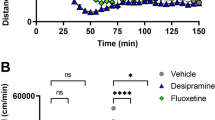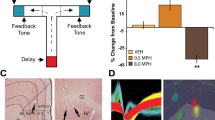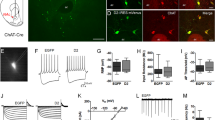Abstract
Atomoxetine has been approved by the FDA as the first new drug in 30 years for the treatment of attention deficit/hyperactivity disorder (ADHD). As a selective norepinephrine uptake inhibitor and a nonstimulant, atomoxetine has a different mechanism of action from the stimulant drugs used up to now for the treatment of ADHD. Since brain acetylcholine (ACh) has been associated with memory, attention and motivation, processes dysregulated in ADHD, we investigated the effects of atomoxetine on cholinergic neurotransmission. We showed here that, in rats, atomoxetine (0.3–3 mg/kg, i.p.), – increases in vivo extracellular levels of ACh in cortical but not subcortical brain regions. The marked increase of cortical ACh induced by atomoxetine was dependent upon norepinephrine α-1 and/or dopamine D1 receptor activation. We observed similar increases in cortical and hippocampal ACh release with methylphenidate (1 and 3 mg/kg, i.p.) – currently the most commonly prescribed medication for the treatment of ADHD – and with the norepinephrine uptake inhibitor reboxetine (3–30 mg/kg, i.p.). Since drugs that increase cholinergic neurotransmission are used in the treatment of cognitive dysfunction and dementias, we also investigated the effects of atomoxetine on memory tasks. We showed that, consistent with its cortical procholinergic and catecholamine-enhancing profile, atomoxetine (1–3 mg/kg, p.o.) significantly ameliorated performance in the object recognition test and the radial arm-maze test.
This is a preview of subscription content, access via your institution
Access options
Subscribe to this journal
Receive 12 print issues and online access
$259.00 per year
only $21.58 per issue
Buy this article
- Purchase on Springer Link
- Instant access to full article PDF
Prices may be subject to local taxes which are calculated during checkout








Similar content being viewed by others
References
Caballero J, Nahata MC . Atomoxetine hydrochloride for the treatment of attention-deficit/hyperactivity disorder. Clin Ther 2003; 25: 3065–3083.
Spencer T, Biederman J, Wilens T . Nonstimulant treatment of adult attention-deficit/hyperactivity disorder. Psychiatr Clin North Am 2004; 27: 373–383.
Everitt BJ, Robbins TW . Central cholinergic systems and cognition. Annu Rev Psychol 1997; 48: 649–684.
Ichikawa J, Dai J, O'Laughlin IA, Fowler WL, Meltzer HY . Atypical, but not typical, antipsychotic drugs increase cortical acetylcholine release without an effect in the nucleus accumbens or striatum. Neuropsychopharmacology 2002; 26: 325–339.
Shirazi-Southall S, Rodriguez DE, Nomikos GG . Effects of typical and atypical antipsychotics and receptor selective compounds on acetylcholine efflux in the hippocampus of the rat. Neuropsychopharmacology 2002; 26: 583–594.
Bymaster FP, Katner JS, Nelson DL, Hemrick-Luecke SK, Threlkeld PG, Heiligenstein JH et al. Atomoxetine increases extracellular levels of norepinephrine and dopamine in prefrontal cortex of rat: a potential mechanism for efficacy in attention deficit/hyperactivity disorder. Neuropsychopharmacology 2002; 27: 699–711.
Paxinos G, Watson C . The Rat Brain in Stereotaxic Coordinates. Academic Press: New York, 1982.
Damsma G, Westerink BH, de Boer P, de Vries JB, Horn AS . Basal acetylcholine release in freely moving rats detected by on-line trans-striatal dialysis: pharmacological aspects. Life Sci 1988; 43: 1161–1168.
Tzavara ET, Davis RJ, Perry KW, Li X, Salhoff C, Bymaster FP et al. The CB1 receptor antagonist SR141716A selectively increases monoaminergic neurotransmission in the medial prefrontal cortex: implications for therapeutic actions. Br J Pharmacol 2003; 138: 544–553.
Wolff MC, Leander JD . SR141716A, a cannabinoid CB1 receptor antagonist, improves memory in a delayed radial maze task. Eur J Pharmacol 2003; 477: 213–217.
Staubli U, Rogers G, Lynch G . Facilitation of glutamate receptors enhances memory. Proc Natl Acad Sci USA 1994; 91: 777–781.
Pussinen R, Sirvio J . Effects of cycloserine, a positive modulator of N-methyl-aspartate receptors, and ST 587, a putative alpha-1 adrenergic agonist, individually and in combination, on the non-delayed and delayed foraging behaviour of rats assessed in the radial arm maze. J Psychopharmacology 1999; 13: 171–179.
Ennaceur A, Delacour J . A new one-trial test for neurobiological studies of memory in rats. 1: behavioral data. Behav Brain Res 1988; 31: 47–59.
Ennaceur A, Meliani K . Effects of physostigmine and scopolamine on rats' performances in object-recognition and radial-maze tests. Psychopharmacology (Berlin) 1992; 109: 321–330.
Acquas E, Fibiger HC . Chronic lithium attenuates dopamine D1-receptor mediated increases in acetylcholine release in rat frontal cortex. Psychopharmacology (Berlin) 1996; 125: 162–167.
Acquas E, Wilson C, Fibiger HC . Nonstriatal dopamine D1 receptors regulate striatal acetylcholine release in vivo. J Pharmacol Exp Ther 1997; 281: 360–368.
Raiteri M, Del Carmine R, Bertollini A, Levi G . Effect of sympathomimetic amines on the synaptosomal transport of noradrenaline, dopamine and 5-hydroxytryptamine. Eur J Pharmacol 1977; 41: 133–143.
Gresch PJ, Sved AF, Zigmond MJ, Finlay JM . Local influence of endogenous norepinephrine on extracellular dopamine in rat medial prefrontal cortex. J Neurochem 1995; 65: 111–116.
Day JC, Fibiger HC . Dopaminergic regulation of septohippocampal cholinergic neurons. J Neurochem 1994; 63: 2086–2092.
Day J, Fibiger HC . Dopaminergic regulation of cortical acetylcholine release. Synapse 1992; 12: 281–286.
Zaborszky L, Cullinan WE . Direct catecholaminergic-cholinergic interactions in the basal forebrain. I. Dopamine-beta-hydroxylase- and tyrosine hydroxylase input to cholinergic neurons. J Comp Neurol 1996; 374: 535–554.
Auld DS, Kornecook TJ, Bastianetto S, Quirion R . Alzheimer's disease and the basal forebrain cholinergic system: relations to beta-amyloid peptides, cognition, and treatment strategies. Prog Neurobiol 2002; 68: 209–245.
Anagnostaras SG, Murphy GG, Hamilton SE, Mitchell SL, Rahnama NP, Nathanson NM et al. Selective cognitive dysfunction in acetylcholine M1 muscarinic receptor mutant mice. Nat Neurosci 2003; 6: 51–58.
Tzavara ET, Bymaster FP, Felder CC, Wade M, Gomeza J, Wess J et al. Dysregulated hippocampal acetylcholine neurotransmission and impaired cognition in M2, M4 and M2/M4 muscarinic receptor knockout mice. Mol Psychiatry 2003; 8: 673–679.
Granon S, Faure P, Changeux JP . Executive and social behaviors under nicotinic receptor regulation. Proc Natl Acad Sci USA 2003; 100: 9596–9601.
Myhrer T . Neurotransmitter systems involved in learning and memory in the rat: a meta-analysis based on studies of four behavioral tasks. Brain Res Brain Res Rev 2003; 41: 268–287.
Sweeney JE, Bachman ES, Coyle JT . Effects of different doses of galanthamine, a long-acting acetylcholinesterase inhibitor, on memory in mice. Psychopharmacology (Berlin) 1990; 102: 191–200.
Cai JX, Arnsten AFT . Dose-dependent effects of the dopamine D1 receptor agonists A77636 or SKF81297 on spatial working memory in aged monkeys. J Pharmacol Exp Ther 1997; 282: 1–7.
Flood JF, Uezu K, Morley JE . Effect of histamine H2 and H3 receptor modulation in the septum on post-training memory processing. Psychopharmacology (Berlin) 1998; 140: 279–284.
Popke EF, Mayorga AJ, Fogle CM, Paule MG . Effects of acute nicotine on several operant behaviors in rats. Pharmacol Biochem Behav 2000; 65: 247–254.
Andersen JM, Lindberg V, Myhrer T . Effects of scopolamine and D-cycloserine on non-spatial reference memory in rats. Behav Brain Res 2002; 129: 211–216.
Lidow MS, Koh P-O, Arnsten AFT . D1 dopamine receptors in the mouse prefrontal cortex: immunocytochemical and cognitive neuropharmacological analyses. Synapse 2003; 47: 101–108.
Soncrant TT, Raffaele KC, Asthana S, Berardi A, Morris PP, Haxby JV . Memory improvement without toxicity during chronic, low dose intravenous arecoline in Alzheimer's disease. Psychopharmacology (Berlin) 1993; 112: 421–427.
Canal N, Imbimbo BP . Relationship between pharmacodynamic activity and cognitive effects of eptastigmine in patients with Alzheimer's disease. Eptastigmine Study Group. Clin Pharmacol Ther 1996; 60: 218–228.
Braida D, Sala M . Eptastigmine: ten years of pharmacology, toxicology, pharmacokinetic, and clinical studies. CNS Drug Rev 2001; 7: 369–386.
Author information
Authors and Affiliations
Corresponding author
Rights and permissions
About this article
Cite this article
Tzavara, E., Bymaster, F., Overshiner, C. et al. Procholinergic and memory enhancing properties of the selective norepinephrine uptake inhibitor atomoxetine. Mol Psychiatry 11, 187–195 (2006). https://doi.org/10.1038/sj.mp.4001763
Received:
Revised:
Accepted:
Published:
Issue Date:
DOI: https://doi.org/10.1038/sj.mp.4001763
Keywords
This article is cited by
-
Theory of visual attention (TVA) applied to rats performing the 5-choice serial reaction time task: differential effects of dopaminergic and noradrenergic manipulations
Psychopharmacology (2023)
-
Differential roles for cortical versus sub-cortical noradrenaline and modulation of impulsivity in the rat
Psychopharmacology (2017)
-
Atomoxetine accelerates attentional set shifting without affecting learning rate in the rat
Psychopharmacology (2015)
-
Treatment of Psychosis and Dementia in Parkinson’s Disease
Current Treatment Options in Neurology (2014)
-
Neonatal Lesions to the Catecholaminergic System Prevents Formation of the Cholinergic Innervation of the Rat Neocortex
Neuroscience and Behavioral Physiology (2013)



